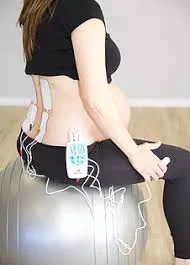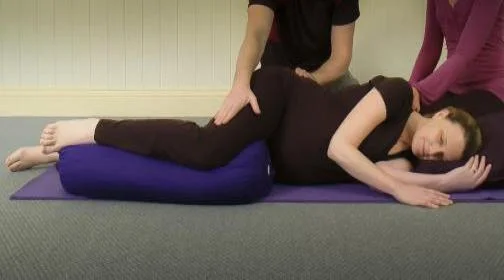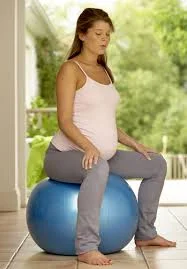Midwives know that when a labouring woman feels safe, private and unobserved she will move unrestrictedly, make sounds uninhibitedly and will more closely follow her instincts. Making sounds during labour helps you to shift your consciousness into a deeper, calmer state of mind thus optimising your birthing hormones helping you labour more efficiently. There is also a physiological connection between the vocal cords and cervix.
Read MoreI would like to thank you for running the yogababy classes and for keeping on doing so during these strange times of self-isolation. It was very important for me to still be able to do it from home. I am sure the only reason why my pregnancy was so easy and delivery was fast (according to the midwife, my impression: it was way too long:) is due to yoga classes. I tried my best to use some of the yoga practices during labour and it helped to progress it. Our baby girl Emily arrived on term without any artificial stimulants.
Read MoreI had my baby Eva on her due date! and the labour went great! I had a natural birth and used the vocalisation and breathing from your Active Birth yoga classes. I had no stitches and she was 3.5kgs (and she’s perfect!).
My water broke and my contractions started soon after, my partner came and picked me up and we went to the hospital (I expected to be sent back home). When we got there and I was checked out the midwife told me I was in active labour! As the contractions got stronger my partner would breathe with me through the pain and when the pain grew stronger I started to make low pitched sounds (like from class) which really helped me with the pain!
Read MoreYour partner can play a vital role in helping you to focus on your breathing during labour & birth. Your breath is your focus for assisting you to adapt to the sensations of labour. Here are three exercises can practice in the lead up to your birth experience.
1. Yogic breath: When you practice the yogic breath during contractions you will be signalling to your body that you accept the bodily sensations as healthy & safe! This will make all the difference between tension and relaxation.
Read MoreTasting embodiment through a contraction was such a gift. I would be embodied one contraction but then not the next; it ebbed and flowed seemingly out of my control. And so a deeper layer of surrender was able to happen, as I realised that birth would happen regardless. My experience was somehow out of my hands so to ride with the 'what is'. But no romanticism-- there were definitely times I wanted OUT or didn’t’ think I could be with it much longer. But knowing that the struggle and fight with what is happening is part of the birth spectrum- helped to get me thru. This is one part of the intense yin/yang that happens. Ultimately I found surrendering to the lack of control of my own experience intensely healing for my previous birth too- as I had been holding on to self-judgment for not having 'done it better'. Somehow, I found the willingness to drop my expectation that it would be a certain way and felt resourced with tools. Birth is HUGE!
I completely recommend Suzanne’s private session wholeheartedly. It honestly is a must for anyone going into the birth experience. It is the biggest gift I could have given to myself for such a huge rite of passage.
Read MoreWe cannot control how birth unfolds and it can be overwhelming when trying to make sense of it, right in the middle of the unknown. How do you know what to do when unplanned things happen? The best thing you can do is educate yourself so you are aware of as many options as possible and then, trust your intuition. Ask yourself “How am I feeling?”, “do I need to do more?” or “do I need to rest?”. Listen, your own heart can never lead you astray. Your satisfaction with your birth has been demonstrated to be related to whether or not you listened to yourself, and importantly whither you were listened to and supported by those caring for you.
Read MoreI am reading the book ‘Your medical mind, how to decide what is right for you’ by Groopman,MD & Hartzband, MD. They say that patients should be aware that doctors and other experts may frame information in a way that reflects their own preferences. What is recommended is that information should be presented in a neutral way and doctors work to understand their patient’s own thinking.
Read MoreThe ability to squat with both heels flat on the ground indicates good pelvic movement for labour and birth. While relaxing is important, learning to untuck your tail bone will assist you to breath your baby out, letting gravity do the job rather than having to push your baby out. To learn to release the tail bone, we need to start sitting on our sit bones more, walk more, squat more and do more yoga! Learning to squat is a regular practice in our Active Birth Yoga classes.
Read More“Attending the yogababy classes made me confident through the pregnancy which translated to being a more confident Mum” Being able to move gives you confidence in your pregnancy.
Read MoreWhile an active birth involves the freedom to move and use upright positions, it is more than just positioning. “An active birth is one in which the birthing mother is in charge of her choices and decisions, thus enabling her to enjoy a productive and mutually respectful partnership with her birth attendants” (Janet Balaskas).
With this in mind any birth, whether natural or assisted, may be called an active birth.
Read MoreGoing to hospital in established labour is recommended for first time, low risk pregnant mothers with spontaneous labours that have started at home. There is some great research that shows it is better to wait till you’re in established or active labour before going to hospital. You increase your risks of a Cesarean birth if you go into early. Attend a Active Birth Workshop with your partner to gain the confidence to stay home and manage labour and then go to hospital knowing you are in good established labour.
Read More
When I was in labour I had a picture of a lotus flower on my mantelpiece. I remember clearly looking into the centre of the flower during labour surges and seeing the petals flowing outwards. My mind was transformed into another place as I imagined my cervix like the flower opening.
Read MoreThe TENS machine is really good to start in early labour to help you relax and find a rhythm with your contractions. When labour gets stronger and more regular you will probably find you will need other comfort measures like massage and shower/bath
Read MoreDuring labour, listen to, be patient and trust, your body will let you know what to do. I have found that while women draw heavily on the birthing skills we learn in the Active birth yoga classes, the one’s that cope well usually do more than what they have learned in class. They discover their own ways of adapting spontaneously to the increase of physical demand that active labour brings.
Read MoreYour own postural awareness and habits in your last trimester can potentially encourage your baby to lie with his or her back to your left front/side (occipito anterior) so that the baby's head engages in the pelvic brim in this position. This will increase the potential for a normal and straightforward birth.
Read MoreA birth ball is simply an exercise ball that helps baby to rotate in labour. In pregnancy it is good to strengthen & balance and in labour it can help strengthen contractions. It's good to sit with your knees slightly lower than your hips so your in an anterior position with the pelvis. You an then make figure 8, circles, rocking and swaying movements to open the inlet of your pelvis so your baby can engage in the last weeks of your pregnancy.
Read MoreWhichever avenue you decide upon, you can create your ideal birthing space with a little forward planning. You should be free to change the layout of the room and individualise it to suit you.
Here are my top tips for creating your ideal birthing space:
Read MoreOpen your heart....A practice for birth....Imagine a flower… a flower special to you….one you love to admire…see the flower as a tightly closed bud…hold the image still…see the colour of the petals and how they are wrapped around each other...very gradually,
Read MoreA Birth Preference is a written record that gets your goals and wishes for your labour and birth across to the people providing you care.
Read More



















